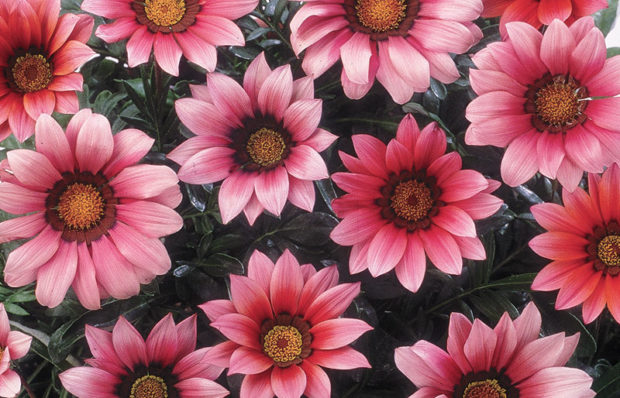
by George Papadelis
Gazania are a multi-purpose plant with high-performance dose of both attractive flowers and showy foliage. They are one of the most durable annuals available for full sun, lots of heat, and minimal water. Gardeners in New Mexico and Arizona have made this one of their most popular bedding plants along with other heat tolerant annuals like vinca, verbena, and zinnias. Gazanias have brilliant 3- to 4-inch daisy-like flowers in shades of yellow, orange, brown, pink, red, and ruby. The individual petals are pointed, sometimes curled, and may be more than one color. The base of each petal may be uniquely marked by a completely different color such as olive, brown or black. Others, like the variety ‘Daybreak Red Stripe,’ have bright yellow flowers with a red stripe the full length of each petal. The flower centers of most gazanias are shades of gold. These bright color combinations and a history of low maintenance have made this African native popular.

The foliage of gazanias is also very attractive. The long, thick leaves of most varieties are blue-green on top and silver on the bottom. This silver sheen makes gazanias extra attractive even when they are not in flower. One variety called ‘Talent’ has flowers that are multi-colored and leaves that are very silvery on the top and bottom. In fact, they are so silver that plants that are not in flower are often mistaken for the completely silver annual called dusty miller. I love using this 10-inch tall variety as a silver ribbon to plant in front of blue annuals such as heliotrope or mealycup sage (Salvia farinacea). The gazania foliage and flower combo makes it perfect for containers when planted all by itself or with a cascading blue partner such as fan flower (Scaevola) or miniature trailing morning glory (Convolvulus sabatius).
Those of you searching for interesting annuals to help add color to perennial plantings may want to consider gazanias. The silver foliage of plants like gazanias can be used to combine and soften other colors in your perennial beds. Some varieties can be found with flowers of separate colors. The Daybreak series, for example, has flowers available in yellow, orange, pink, white, bronze, as well as the red-striped variety. The Chansonette series is available in six colors as well. These work well in both perennial plantings and annual combinations. Try a yellow variety with red salvia or an orange variety with purple petunias.

Gazanias have an interesting trait that should be considered before planting. If you would like to enjoy your gazania flowers in the evening, you may need to resort to a photograph. Gazania flowers close when the sun sets and reopen each morning. They also stay closed when it becomes cloudy and when it gets too cold. Therefore, if you need flowers 24 hours a day, gazanias may not be for you. On the positive side, gazanias are both frost and freeze tolerant. They can be planted in mid-April when few other annuals will survive. In fact, some parts of the country call this plant a perennial (it is hardy to zone 8).
Gazanias are extremely low maintenance. Once established, watering will rarely be necessary. Individual flowers last for several weeks so spent blooms will seldom need removal. Take advantage of this plant’s durability, versatility, and ease of care. Try it in your perennial beds, annual plantings, or containers. Even in your sunniest, hottest, driest area, its flowers and foliage promise to provide an interesting and showy display long into the fall.

Gazania (gah-ZAY-nee-uh)
Common name: Gazania
Plant type: Annual (a tender perennial)
Plant size: Height: 8-10 inches, Width: 10 inches
Habit: Low-growing, with basal leaves and long-stalked flowers
Flower colors: Yellow, orange, red, pink, white, bronze; flower centers can be gold, olive or brown
Flower size: 3-4 inches across
Bloom period: Early summer to frost
Leaf color: Blue-green on top, silver on bottom; ‘Talent’ series is all silver
Leaf size: Length: 4-5 inches, Width: 1/2 inch
Light: Full sun
Soil: Well-drained, light, sandy; tolerates dry, hot soil
Uses: Annual beds, containers, perennial borders
Companion plants: Salvias, petunias; other drought-tolerant plants (verbena, vinca, zinnia)
Remarks: Needs minimal water; flowers close in the evening; attractive foliage
George Papadelis is the owner of Telly’s Greenhouse in Troy and Shelby Township, MI.
Related: Gazania at Missouri Botanical Garden

Leave a Reply